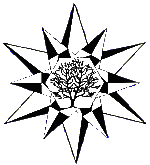Some of you, I hope, will be aware that there is a level of project Myra beyond the stories and the pictures, beyond even the role-playing games - it is the PBeM level of historical simulation, where conquest and strife between nations is handled in a Play-By-eMail game which is more complex than many strategic boardgames, but much less complicated than many wargames or purely computer-moderated online-games. That game, "World of the Hexagons" (Welt der Waben, WdW) has been played continously since 1982, with one year in our world used to simulate one year on Myra. It is these over 20 years of historic simulations, of wars, strife, diplomacy and intrigue that actually "truly happened", not in the mind of a single author, but from the conflict of interests between dozens, yes hundreds of people, which give the world Myra as a setting much of its depth.
The first continent on which the game started was Karcanon, the one which is now the first to be gradually transferred into English for your perusal and easier involvement. See http://www.karcanon.de for the state of progress back then. The second one, in the Machairas of Karcanon, is Karnicon, called "K2" by lazy abbreviators, where I played (and could have used the support of more experienced generals and more creative writers for my kingdom). The map shown here for demonstration purpose is from K2, and I suppose it is 'safe' to show here as none of you will be playing there, except, perhaps, with my in my kingdom - because Karnicon will stay German language only, as far as I can tell today - even though the relevant gamemaster for my area, the coordinator of that part of the world, User:Al.moccero, is also a contributer here.
As you can see below, the maps are shown with a hexagon-grid of Grand Fields (GFs) with a unique three-digit number, each of the GFs is divided into 48 small hexes (KFs). Each KF is about 100x100 km in size, the grid, therefore, is still a quite general one - levels of detail below that are the responsibility of the person who controls that piece of land in the simulation. They can create detailed maps for their stories or role-playing games.
The directions, accordingly, are the directions of the six sides of the GF if you talk about general directions and far-off locations, and the six sides of the KF if you're talking about the next castle or village.
The colour-code of the map is as follows: First, height levels -1 to +4
- dark blue = deep sea, the area of maelstroms, kraken and other monsters, level -1
- light blue = sea, safe to sail in areas near coasts of level 1, no taxes, level 0
- light green = fertile plains, 50,000 inhabitants, 3,000 Gold taxes, ground level 1
- light brown (orange) = rolling hills, low mountains, 25,000 inhabitants, 1,500 Gold taxes, level 2
- dark brown = mountain areas between 1500 and 3000 meters high, 10,000 inhabitants, 900 Gold taxes, level 3
- grey = high mountain areas 4,000 meters and above, 5,000 inhabitants, 300 Gold taxes, level 4
Terrainmodifiers are as follows, and show in the middle of the height level ofa hex. Note that a colour denotes the predominant feature, noteverything, in a KF
- dark green - forests
- olive green - jungle
- purple - swamp
- yellow - desert
- red - volcano
- white - ice
Buildings and further markers are as follows:
- Red square - Capital city, up to 100,000 inhabitants, 8,000 Gold taxes
- Red point in circle - Fortress, fortified city, 50,000 inhabitants, 4,000 Gold
- Red point - City, like fortress but lesser defensive value
- Red circle - Castle, ca.1000 inhabitants, 100 Gold taxes, good defensive value
- Red triangle - Temple for at least 10,000, often 50,000 gold pieces
- Red line from hex to hex: paved road, doubles the speed of units while on it.
- Red line on hex sides - fortification or wall between hexes
- Blue line - on hex-sides: large rivers, expensive to cross except on bridges
- Black line - on hex sides: Coast lines, usually give a basic defensive value
